How to Make a Pi Day Necklace or Bracelet

It's less than a week to go until Pi Day (14th March), an annual celebration of the mathematical constant π (pi).
To celebrate Pi Day, we're showing you two different ways to make a necklace or bracelet that will help you memorise the digits of pi. Make some to wear on Pi Day, or to share with a maths loving friend.
Watch the video below for a quick overview, then scroll down for more detailed instructions.
What is pi?
Pi is a mathematical constant that is the ratio of a circle's circumference to its diameter. Regardless of the circle's size the ratio will always equal pi, approximately 3.14159 though its decimals are infinite. No one knows how pi ends, but so far scientists have calculated over 100 trillion decimals of pi.
How to make a Pi Day necklace
To make a Pi Day necklace, you will need:
- some string or wool
- small beads in a variety of colours
- a pair of scissors
- some sticky tape (optional)
- a note of the first 20-30 digits of pi
The first 50 digits of pi are: 3.1415926535897932384626433832795028841971693993751...
To make your necklace, thread groups of coloured beads on to your string or wool, with the number of beads in each group representing the next digit of pi. For example, 3 orange, 1 white, 4 green, 1 red and so on, because pi starts with 3.141
Tip: Wrapping a small piece of sticky tape round the end of your string stops it from fraying and makes it easier to get the beads on!
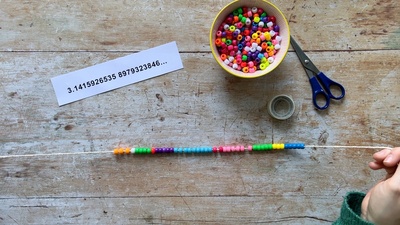
When you've finished threading, cut the string to the length you want and tie it off with a knot.
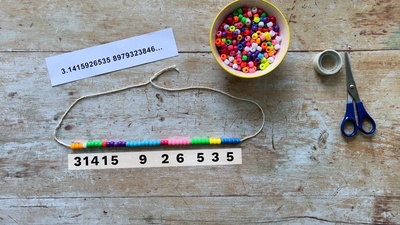
In the video, we used a different colour for each digit, but you can use as many or few colours as you like. You will need a minimum of two colours, so that you can alternate. As you can see below, for our second necklace we only used three colours.
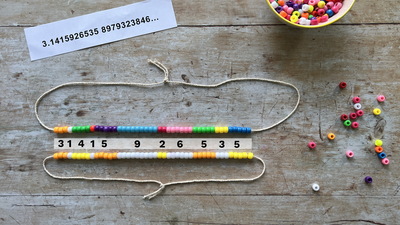
For our necklaces we went up to ten decimals of pi, but you can make your necklace longer if you want.
This method of making a pi necklace is great for helping children to memorise the digits of pi, as each group of beads equals the value of the digit that comes next. You would only be able to go up to 32 digits though - can you figure out why?
How to make a Pi Day bracelet
To make a Pi Day bracelet, you will need:
- a pipe cleaner
- small beads in a variety of colours
- a pen and paper or our Pi Day Bracelet Worksheet
To make our bracelets, we used a colour code to represent the digits of pi. You will need a different colour of bead for each number from 0 to 9. Write down the colours for each number , so that you don't get muddled up!
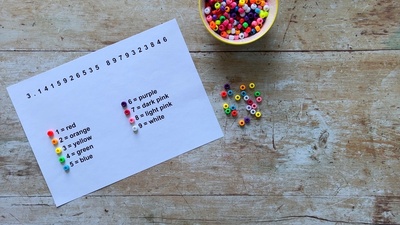
Use the designated colours to match the corresponding digits of pi, and thread them on to your pipe cleaner in that order. For example, if 1 =red, 2=orange, 3=yellow, and 4=green, your bracelet would start with yellow (3), red (1), green (4), red (1) because pi starts with 3.141
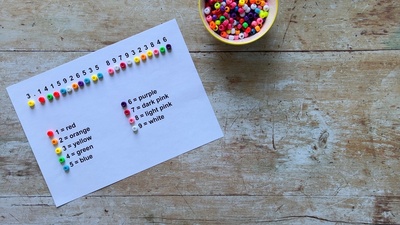
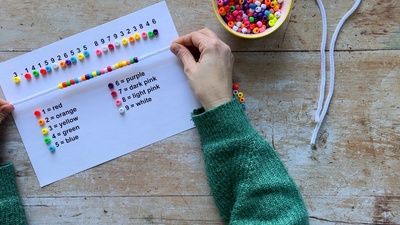
You might notice that in our video we only used numbers 1 to 9. That's because you will only need the 0 if you make it as far as the 33rd digit*, and our bracelets were shorter than that. Use as many digits of pi as you need to get the right size, then twist the pipe cleaner together at the end to complete the bracelet.
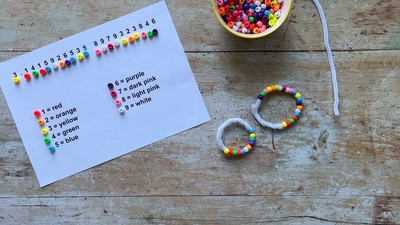
The colour code method is a little harder to use as a memory aid, as you'll need to remember what each colour stands for, but it lets you add more digits of pi as you're using just one bead per digit. Of course, you can use either method to make a Pi Day necklace or bracelet - just adjust the number of digits to suit the length of necklace or bracelet you want to make.
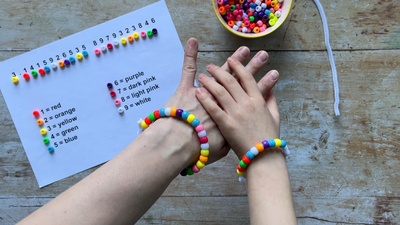
*Did you figure out why you can only make the necklace from the first method up to 32 digits? That's right, because the 33rd digit is a 0 and if you string zero beads on to your necklace it would be difficult to remember where the zeros were!
Latest News and Events

Maths Week 2026: Maths Matters
Maths Week Scotland is back for 2026 with the theme Maths Matters. To celebrate our tenth year, we will have an extended gala week running over two weekends, from Saturday 19 to Sunday 27 September.

RSPB Big Schools' Birdwatch
It is almost time for the RSPB Big Schools’ Bird Watch – the largest citizen science project for schools across the UK. Sign up to take part, from 6th January- 13th February 2026.
